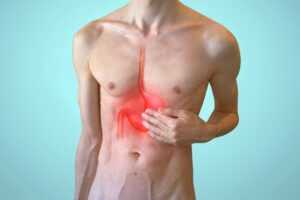[su_divider top=”no” style=”double” divider_color=”#952524″ link_color=”#952524″ size=”2″ margin=”10″]
What is Achalasia Cardia? What are the symptoms of Achalasia Cardia? How can homeopathy help you? All of this is answered, in this post, and of course, our doctors are always there to help you. Just fill in your details in the form down below and we will answer all your questions for FREE!
[su_divider top=”no” style=”double” divider_color=”#952524″ link_color=”#952524″ size=”2″ margin=”10″]
[sc name=”query”]
What is Achalasia Cardia?
Achalasia Cardia is a rare condition of the esophagus which prevents food from entering the stomach due to improper functioning of the lower esophageal sphincter.
The esophagus is a pipe-like structure through which food travels from the mouth to the stomach. At the point where the lower end of the pipe meets the stomach, there is a ring-like structure called the lower esophageal sphincter. The food enters the stomach when this sphincter relaxes. Then it contracts to prevent the backflow of stomach contents into the esophagus. When the lower esophageal sphincter fails to relax, the condition is called Achalasia Cardia, and the food does not enter the stomach.
Who gets Achalasia Cardia?
People in the age group of 25-60 are more prone to this condition. But nowadays children are also dealing with the same disorder. Both men and women are equally affected, and the condition does not run in families.
Also Read: Causes of Dysphagia
What causes Achalasia cardia?
The primary region of damage is the esophageal mesenteric plexus and includes autoimmune reactions. This reaction attacks the nerve cells in the muscular layer of the esophageal wall and the lower esophageal sphincter. The nerve cells which control the relaxation and contraction of the muscle fibers start degenerating. Thus, the Lower esophageal sphincter fails to function, and the food and liquids can’t pass through the pipe.
What are the symptoms of Achalasia Cardia?
The primary symptom of Achalasia cardia is dysphagia (difficulty swallowing). The food can’t pass through the esophagus and eventually passes back into the mouth.
- Chest pain comes and goes suddenly.
- Heartburn
- Nocturnal cough
- Pneumonia (due to aspiration of food into the lungs)
- Burping
- Vomiting
- Weight loss
- GERD
- Dryness of mouth and throat
- Hiccups (less common)
How is Achalasia diagnosed?
First, a physical examination might be performed.
However, physical examination is not enough. Some following tests should be performed to understand and diagnose this condition:
- X-ray imaging: To evaluate the structure of the esophagus.
- Barium swallow: Barium solution is swallowed, and its path is evaluated along the esophagus using X-rays.
- Esophageal manometry: This test measures the force, timing, and efficiency of muscular contractions of the esophagus and the lower esophagus sphincter. The absence of these contractions is taken as a positive sign of achalasia cardia.
- Upper gastrointestinal endoscopy: This test gives a clear view of the inner esophageal wall. In this test, a narrow tube with a camera called an endoscope, is inserted down the esophagus, and the images are seen on the screen.
Also Read: Diagnosis of Achalasia Cardia
Is this treatable?
Yes, this condition is treatable. The main goal is to relieve the suffering so that the food and drinks can be swallowed and passed through the esophagus to the stomach. There are some surgical and some non-surgical treatments available:
Surgical:
- Balloon dilatation- In this procedure, a specifically designed balloon is inserted in the lower esophageal sphincter and inflated. It makes the muscular fibers relax so that the food passes to the stomach.
- Laparoscopic Heller Myotomy (LHM)- In this procedure, the muscle fibers of the lower esophageal sphincter are cut. An additional procedure called fundoplication is performed to deal with the side effects of LHM i.e., GERD.
- Peroral Endoscopy Myotomy (POEM)- In this procedure, the muscles around the esophagus, lower esophageal sphincter, and fundus are cut with a knife. This causes the relaxation of muscle fibers, and the food enters the stomach directly.
Non-surgical:
If surgery is not an option, the botulinum toxin injections can relax muscles. These injections need to be repeated to maintain the control of symptoms.
Also Read: Treatment Available for Achalasia
Is there any scope of homeopathy in treating achalasia cardia?
Homeopathy provides symptomatic relief to the patient of achalasia cardia. It helps to manage the suffering in mild to moderate cases. There are several medicines that aim to treat the cases without any side effects. Some of them are as follows:
- Alumina
- Phosphorus
- Lachesis
- Nux vomica
- Carbo vegetabilis
Also Read: Homeopathic Management of Achalasia
Can the cases get complicated after surgery?
Achalasia cardia is an incurable, neurological disorder and needs lifetime treatment and monitoring even after surgery. The case can lead to the following complications if not observed carefully:
- Bloating
- GERD (gastroesophageal reflux disease)
- Formation of a hole in the esophagus
- Failure of surgery and recurrence
Can the cases return after surgery?
Recurrence is common in cases of achalasia cardia after surgery. There are multiple causes for recurrence but the primary cause in early return is the incomplete myotomy and in late recurrence is the fibrosis due to myotomy.
Also Read: Lifestyle Management for Achalasia
Is achalasia cardia curable?
No, achalasia cardia is a lifelong condition. We can manage the symptoms with relaxation and contraction of LES so that food and liquid can pass easily through the food pipe.
Is achalasia cardia a hereditary disorder?
No, it is not a hereditary condition.
What are the complications of achalasia cardia?
- GERD
- Esophagitis
- Malnutrition
- Pneumonia
- Lung infections
- Esophageal cancer
- Bleeding from the GIT
- Perforation of the esophagus
Also Read: Complications of Achalasia Cardia
What happens if it is left untreated?
It is serious if left untreated. Patients with achalasia cardia have trouble eating food and drinking fluids. It can result in weight loss and malnutrition. This condition can also result in esophageal cancer if left untreated for a long period of time.
It can also be represented as a dilated and tortuous esophagus, which may occur in patients who have already been treated surgically yet no improvement in dysphagia is seen. In such cases, esophagectomy is the only option.
What is the difference between achalasia cardia and GERD?
Both disorders are related to the lower esophageal sphincter which is a barrier between the esophagus and stomach. In GERD, the LES doesn’t close after emptying the esophagus and resulting in the reflux of stomach contents back to the esophagus. While in achalasia cardia, the LES doesn’t open properly when it should and thus food gets stuck in the lower end of the esophagus.
How can you determine if you have achalasia cardia or GERD?
When you find gastric contents coming back to the esophagus after swallowing, it is gastroesophageal reflux disease and if there is difficulty in swallowing the food or sensation as if food is stuck in the esophagus, it is achalasia cardia.
Also Read: Foods To Avoid in Achalasia
Is there any specific diet for Achalasia?
No, there is no specific diet for achalasia. Usually, patients make some dietary alterations by themselves as food passes much more easily.
- Eating slowly, taking small bites, and chewing properly is an important things to take care of in this condition.
- Liquids pass much more easily than solid food items. Sometimes the patients drink a lot of water in between meals so they can pass through the sphincter easily.
- Avoid having large meals. In fact, start having small-volume meals.
- Eat foods like greasy meat, dry foods, or raw vegetables with good care.
Also Read: Foods to eat in Achalasia
Is there any relation to your sleeping posture with Achalasia cardia?
Yes, the sleeping posture can help manage your suffering. Use head risers under the mattress as it promotes esophageal emptying into the stomach.
For more information, you can visit Healthline and Mayoclinic
Achalasia Cardia- Detailed Description
[su_divider divider_color=”#952524″ link_color=”#952524″ size=”2″ margin=”10″]
[sc name=”know-your-doctor”]
[sc name=”more-links-diseases”]


